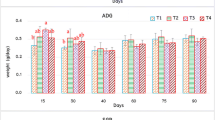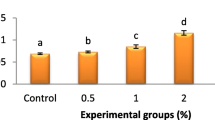Abstract
The main objectives of the present study were to improve the growth performance, survival rate, and hematological indices of fingerling Anabas testudineus, by using Polygonum minus plant leaf extract, sprayed at four different levels (0 as the control group, 50, 70, and 100 ml/kg fish feed), for 60 days. The growth indices and survival rate were investigated at 15-day intervals, while hematological indices were evaluated at the end of experiment (60 days). The results showed that the weight gain (WG), average daily growth rate (ADG), specific growth rate (SGR), feed efficiency (FE), and protein efficiency ratio (PER) values were significantly different, and that the highest value in the group was found in fish fed 70 ml/kg feed. Meanwhile, feed conversion rate (FCR) was shown to have the lowest value in the group that was fed 70 ml/kg feed. In addition, the survival rate was shown to be higher in all groups except for the control group: a significant difference (p < 0.05). Also, the dietary supplementation, with P. minus extract, caused a significant difference in total white blood cell count (WBC) among the treatments, the highest cell value of WBC was found in the group of fish fed 70 and 100 ml/kg feed. Although the red blood cells (RCB) and hematocrit (Htc) concentrations were not significantly different (p > 0.05), there was a trend towards higher concentrations. Overall, our results indicated that P. minus leaf extract supplementation could improve growth performance, especially with regard to feed utilization, and the survival rate was very important for the fingerling nursing step; moreover, the WBC could be improved by using herbal extracts.





Similar content being viewed by others
Change history
06 November 2017
The original version of this paper unfortunately captured the equation incorrectly and is corrected in this article.
References
Adel M, Amiri AA, Zorriehzahra J, Nematolahi A, Esteban MA (2015) Effects of dietary peppermint (Mentha piperita) on growth performance, chemical body composition and hematological and immune parameters of fry Caspian white fish (Rutilus frisii kutum). Fish Shellfish Immunol 45:841–847
Aletor VA, Egberongbe O (1998) Feeding differently processed soybean and haematological indices in the chicken diet. 5th Edition. J. Poult Sci 3:34–36
Baba E, Acar U, Ontas C, Kesbic OS, Yilmaz S (2016) The use of Avena sativa extract against Aeromonas hydrophila and its effect on growth performance, hematological and immunological parameters in common carp (Cyprinus carpio). Ital J Anim Sci 15:325–333
Bagenal T (1978) Methods for the assessment of fish production in fresh waters, 3rd edn. Blackwell Scientific publication, Oxford, London
Bunawan H, Talip N, Noor NM (2011) Foliar anatomy and micromorphology of Polygonum minus Huds. and their taxonomic implications. Aust J Crop Sci 5:123–127
Christapher PV, Parasuraman S, Christina JM, Asmawi M, Vikneswaran M (2015) Review on Polygonum minus. Huds, a commonly used food additive in Southeast Asia. Phcog Res 7:1–6
Dada AA, Sonibare OF (2015) Effect of dietary administration of the herbal additive siamweed (Chromolaena odorata) on growth performance and haematological changes in Clarias gariepinus fingerlings. J Fish 3:221–226
Dent M, Dragovi-Uzelac V, Peni M, Mladen B, Bosiljkov T, Levaj B (2013) The effect of extraction solvents, temperature and time on the composition and mass fraction of polyphenols in Dalmatian wild sage (Salvia officinalis L) extracts. Food Technol Biotechnol 51:84–91
Fallahpour F, Banaee M, Javadzade N (2014) Effects of dietary marshmallow (Althaea Officinalis L.) extract on growth performance and body composition of common carp (Cyprinus Carpio). Int J Adv Biol Biomed Res 2:2453–2460
Feist SW, Longshaw M (2000) Myxosporiodiosis of fish and the bryozoan link with proliferate kidney diseases (PKD) of salmonids. J Fish Dis 1:91–108
Gor MC, Ismail I, Mustapha WAW, Zainal Z, Noor NM, Othman R, Hussein ZAM (2011) Identification of cDNAs for jasmonic acid-responsive genes in Polygonum minus roots by suppression subtractive hybridization. Acta Physiol Plant 33:283–294
Harikrishnan R, Balasundaram C, Heo MS (2010) Herbal supplementation diets on hematology and innate immunity in goldfish against Aeromonas hydrophila. Fish Shellfish Immunol. 28:354–361
Kareem ZH, Abdelhadi YM, Christianus A, Karim M, Romano N (2016) Effects of some dietary crude plant extracts on the growth and gonadal maturity of Nile tilapia (Oreochromis niloticus) and their resistance to Streptococcus agalactiae infection. Fish Physiol Biochem 42:757–769
Kim DS, Noah CH, Jung SW, Jo JY (1998) Effect of Obosan supplemented diet on growth, feed conversion ratio and body composition of Nile tilapia, Oreochromis niloticus. J Aquac 11:83–90
Narasimhulu G, Reddy KK, Mohamed J (2014) The genus Polygonum (Polygonacea): an ethnopharmacological and phytochemical perspectives—review. Int J Pharm Pharm Sci 6:21–45
Pham HNT, Nguyen VT, Vuong QV, Bowyer MC, Scarlett CJ (2015) Effect of extraction solvents and drying methods on the physicochemical and antioxidant properties of Helicteres hirsuta Lour. leaves. Technologies 3:285–301
Panase P, Mengumphan K (2015) Growth performance, length-weight relationship and condition factor of backcross and reciprocal hybrid catfish reared in net cages. Int J Zool Res 11:57–64
Pratheepa V, Sukumaran N (2014) Effect of Euphorbia hirta plant leaf extract on immunostimulant response of Aeromonas hydrophila infected Cyprinus carpio. Peer J 2:e671
Qader SW, Abdulla MA, Chua LS, Najim N, Zain MM, Hamdan S (2011) Antioxidant, total phenolic content and cytotoxicity evaluation of selected Malaysian plants. Molecules 16:3433–3443
Rehulka J (2003) Hematological and biochemical analysis in rainbow trout, Oncorhynchus mykiss affected by viral haemerrhagic septicaemia (VHS). Dis Aquat Org 56:186–193
Sheikhlar A, Alimon AR, Daud H, Saad CR, Ramaezani-Fard E (2011) Effect of crude methanol extract of Euphorbia hirta on hematological and biochemical indices and histological changes of liver in African catfish Clarias gariepinus (Burchell, 1822). J Fish Aquat Sci 6:802–808
Soosean C, Marimuthu K, Sudhakaran S, Xaviear R (2010) Effect of mangosteen (Garcinia mangostana L.) extracts as a feed additive on growth and hematological parameters of African catfish (Clarias gariepinus) fingerlings. Eur Rev Med Pharmacol Sci 14:605–611
Tewary A, Patra BC (2011) Oral administration of baker’s yeast (Saccharomyces cerevisiae) acts as a growth promoter and immunomodulator in Labeo rohita (Ham.) J Aquacult Res Dev 2:1–7
Veerasamy R, Min LS, Mohanraj PR, Sivadasan S, Varghese C, Rajak H, Marimuthu K (2014) Effect of aqueous extract of Polygonum minus leaf on the immunity and survival of African catfish (Clarias gariepinus). J Coast Life Med 2:209–213
Vikram P, Chiruvella KK, Ilfah HB, Ripain A, Arifullah M (2014) A recent review on phytochemical constituents and medicinal properties of kesum (Polygonum minus Linn.) Asian Pac J Trop Biomed 4:923–935
Wigraiboon S, Nomura NP, Whangchai N (2016) Effect of essential oils from Houttuynia cordata Thunb supplemented diets on growth performance and immune response of Hybrid red tilapia (Oreochromis mossambicus Linn. × Oreochromis niloticus Linn.) Int J Fish Aquat Stud 4:677–684
Acknowledgements
We would like to thank School of Agriculture and Natural Recourses, University of Phayao, Thailand, for providing facilities for the present research. Moreover, the authors would like to thank all staffs and students in fisheries program Mr. Laksaman Khantamal, Mr.Weerayut Sujai, Mr.Chayanon Maneejorn and Mr. Jatuporn Siriyan for their help on data collection and herbal fish feed preparation.
Funding
The authors declare there was no funding for the present research.
Author information
Authors and Affiliations
Corresponding author
Ethics declarations
Conflict of interest
The authors declare that they have no conflict of interest.
Ethical approval
All applicable international, national, and/or institutional guidelines for the care and use of animals were followed.
Additional information
The original version of this article was revised: Equation is corrected in this paper.
A correction to this article is available online at https://doi.org/10.1007/s00580-017-2583-3.
Rights and permissions
About this article
Cite this article
Panase, P., Tipdacho, P. Preliminary use of Polygonum minus Linn. leaf extract on growth performance, feed utilization, and some hematological indices of Anabas testudineus (Bloch, 1792). Comp Clin Pathol 27, 147–153 (2018). https://doi.org/10.1007/s00580-017-2566-4
Received:
Accepted:
Published:
Issue Date:
DOI: https://doi.org/10.1007/s00580-017-2566-4




